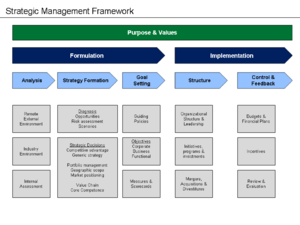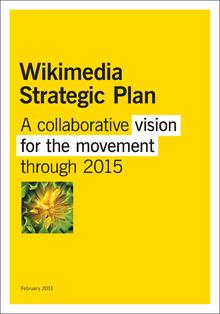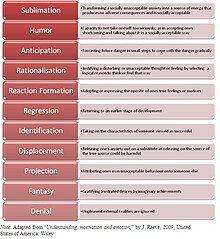Strategic planning is an organization's process of defining its strategy, or direction, and making decisions
on allocating its resources to pursue this strategy. It may also extend
to control mechanisms for guiding the implementation of the strategy.
Strategic planning became prominent in corporations during the 1960s and
remains an important aspect of strategic management. It is executed by strategic planners or strategists,
who involve many parties and research sources in their analysis of the
organization and its relationship to the environment in which it
competes.
Strategy has many definitions, but generally involves setting strategic goals, determining actions to achieve the goals, and mobilizing resources to execute the actions. A strategy describes how the ends (goals) will be achieved by the means (resources). The senior leadership of an organization is generally tasked with determining strategy. Strategy can be planned (intended) or can be observed as a pattern of activity (emergent) as the organization adapts to its environment or competes.
Strategy includes processes of formulation and implementation; strategic planning helps coordinate both. However, strategic planning is analytical in nature (i.e., it involves "finding the dots"); strategy formation itself involves synthesis (i.e., "connecting the dots") via strategic thinking. As such, strategic planning occurs around the strategy formation activity.
Strategy has many definitions, but generally involves setting strategic goals, determining actions to achieve the goals, and mobilizing resources to execute the actions. A strategy describes how the ends (goals) will be achieved by the means (resources). The senior leadership of an organization is generally tasked with determining strategy. Strategy can be planned (intended) or can be observed as a pattern of activity (emergent) as the organization adapts to its environment or competes.
Strategy includes processes of formulation and implementation; strategic planning helps coordinate both. However, strategic planning is analytical in nature (i.e., it involves "finding the dots"); strategy formation itself involves synthesis (i.e., "connecting the dots") via strategic thinking. As such, strategic planning occurs around the strategy formation activity.
Process
Strategic management processes and activities
Overview
Strategic
planning is a process and thus has inputs, activities, outputs and
outcomes. This process, like all processes, has constraints. It may be
formal or informal and is typically iterative, with feedback loops
throughout the process. Some elements of the process may be continuous
and others may be executed as discrete projects with a definitive start
and end during a period. Strategic planning provides inputs for strategic thinking,
which guides the actual strategy formation. Typical strategic planning
efforts include the evaluation of the organization's mission and
strategic issues to strengthen current practices and determine the need
for new programming.
The end result is the organization's strategy, including a diagnosis of
the environment and competitive situation, a guiding policy on what the
organization intends to accomplish, and key initiatives or action plans
for achieving the guiding policy.
Michael Porter wrote in 1980 that formulation of competitive strategy includes consideration of four key elements:
- Company strengths and weaknesses;
- Personal values of the key implementers (i.e., management and the board);
- Industry opportunities and threats; and
- Broader societal expectations.
The first two elements relate to factors internal to the company
(i.e., the internal environment), while the latter two relate to factors
external to the company (i.e., the external environment). These elements are considered throughout the strategic planning process.
Inputs
Data is
gathered from a variety of sources, such as interviews with key
executives, review of publicly available documents on the competition or
market, primary research (e.g., visiting or observing competitor places
of business or comparing prices), industry studies, etc. This may be
part of a competitive intelligence
program. Inputs are gathered to help support an understanding of the
competitive environment and its opportunities and risks. Other inputs
include an understanding of the values of key stakeholders, such as the
board, shareholders, and senior management. These values may be captured
in an organization's vision and mission statements.
Activities
The essence of formulating competitive strategy is relating a company to its environment.
Michael Porter
Strategic planning activities include meetings and other
communication among the organization's leaders and personnel to develop a
common understanding regarding the competitive environment and what the
organization's response to that environment (its strategy) should be. A
variety of strategic planning tools (described in the section below)
may be completed as part of strategic planning activities.
The organization's leaders may have a series of questions they
want to be answered in formulating the strategy and gathering inputs,
such as:
- What is the organization's business or interest?
- What is considered "value" to the customer or constituency?
- Which products and services should be included or excluded from the portfolio of offerings?
- What is the geographic scope of the organization?
- What differentiates the organization from its competitors in the eyes of customers and other stakeholders?
- Which skills and resources should be developed within the organization?
Outputs
The
output of strategic planning includes documentation and communication
describing the organization's strategy and how it should be implemented,
sometimes referred to as the strategic plan. The strategy may include a
diagnosis of the competitive situation, a guiding policy for achieving
the organization's goals, and specific action plans to be implemented. A strategic plan may cover multiple years and be updated periodically.
The organization may use a variety of methods of measuring and monitoring progress towards the strategic objectives and measures established, such as a balanced scorecard or strategy map.
Companies may also plan their financial statements (i.e., balance
sheets, income statements, and cash flows) for several years when
developing their strategic plan, as part of the goal-setting activity.
The term operational budget
is often used to describe the expected financial performance of an
organization for the upcoming year. Capital budgets very often form the
backbone of a strategic plan, especially as it increasingly relates to
Information and Communications Technology (ICT).
Outcomes
Whilst the planning process produces outputs, as described above, strategy implementation
or execution of the strategic plan produces Outcomes. These outcomes
will invariably differ from the strategic goals. How close they are to
the strategic goals and vision will determine the success or failure of
the strategic plan. There will also arise unintended Outcomes, which
need to be attended to and understood for strategy development and
execution to be a true learning process.
Tools and approaches
Video explaining the strategic plan of the Wikimedia Foundation
Wikimedia Movement Strategic Plan (PDF)
A variety of analytical tools and techniques are used in strategic planning.
These were developed by companies and management consulting firms to
help provide a framework for strategic planning. Such tools include:
- PEST analysis, which covers the remote external environment elements such as political, economic, social and technological (PESTLE adds legal/regulatory and ecological/environmental);
- Scenario planning,
which was originally used in the military and recently used by large
corporations to analyze future scenarios. The flowchart to the right
provides a process for classifying a phenomenon as a scenario in the
intuitive logics tradition.
- ;Process for classifying a phenomenon as a scenario in the Intuitive Logics tradition.
- Porter five forces analysis, which addresses industry attractiveness and rivalry through the bargaining power of buyers and suppliers and the threat of substitute products and new market entrants;
- SWOT analysis, which addresses internal strengths and weaknesses relative to the external opportunities and threats;
- Growth-share matrix, which involves portfolio decisions about which businesses to retain or divest; and
- Balanced Scorecards and strategy maps, which creates a systematic framework for measuring and controlling strategy.
- Responsive Evaluation, which uses a constructivist evaluation approach to identify the outcomes of objectives, which then supports future strategic planning exercises.
Strategic planning vs. financial planning
Simply
extending financial statement projections into the future without
consideration of the competitive environment is a form of financial
planning or budgeting, not strategic planning. In business, the term
"financial plan" is often used to describe the expected financial
performance of an organization for future periods. The term "budget" is
used for a financial plan for the upcoming year. A "forecast" is
typically a combination of actual performance year-to-date plus expected
performance for the remainder of the year, so is generally compared
against plan or budget and prior performance. The financial plans
accompanying a strategic plan may include 3–5 years of projected
performance.
McKinsey & Company developed a capability maturity model
in the 1970s to describe the sophistication of planning processes, with
strategic management ranked the highest. The four stages include:
- Financial planning, which is primarily about annual budgets and a functional focus, with limited regard for the environment;
- Forecast-based planning, which includes multi-year financial plans and more robust capital allocation across business units;
- Externally oriented planning, where a thorough situation analysis and competitive assessment is performed;
- Strategic management, where widespread strategic thinking occurs and a well-defined strategic framework is used.
Categories 3 and 4 are strategic planning, while the first two
categories are non-strategic or essentially financial planning. Each
stage builds on the previous stages; that is, a stage 4 organization
completes activities in all four categories.
For Michael C. Sekora, Project Socrates founder in the Reagan White House, during the cold war the economically challenged Soviet Union
was able to keep on western military capabilities by using
technology-based planning while the U.S. was slowed by finance-based
planning, until the Reagan administration launched the Socrates Project,
which should be revived to keep up with China as an emerging superpower.
Criticism
Strategic planning vs. strategic thinking
Strategic planning has been criticized for attempting to systematize strategic thinking and strategy formation, which Henry Mintzberg
argues are inherently creative activities involving synthesis or
"connecting the dots" which cannot be systematized. Mintzberg argues
that strategic planning can help coordinate planning efforts and measure
progress on strategic goals, but that it occurs "around" the strategy
formation process rather than within it. Further, strategic planning
functions remote from the "front lines" or contact with the competitive
environment (i.e., in business, facing the customer where the effect of
competition is most clearly evident) may not be effective at supporting
strategy efforts.
Evidence on strategic planning's impact
While
much criticism surrounds strategic planning, evidence suggests that it
does work. In a recent meta-analysis including data from almost 9,000
public and private organizations, strategic planning is found to have a
positive impact on organizational performance. Strategic planning is
particularly potent in enhancing an organization's capacity to achieve
its goals (i.e., effectiveness). However, the study argues that just
having a plan is not enough. For strategic planning to work, it needs to
include some formality (i.e., including an analysis of the internal and
external environment and the stipulation of strategies, goals and plans
based on these analyses), comprehensiveness (i.e., producing many
strategic options before selecting the course to follow) and careful
stakeholder management (i.e., thinking carefully about whom to involve
during the different steps of the strategic planning process, how, when
and why).





